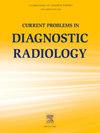Multidetector computed tomography imaging planning for bronchoscopy stent and valve placement in the treatment of COPD, air leaks, and airway stenosis
IF 1.5
Q3 RADIOLOGY, NUCLEAR MEDICINE & MEDICAL IMAGING
引用次数: 0
Abstract
Bronchoscopy using a flexible bronchoscope is considered a safe procedure and has been used for diagnosing and treating airway and parenchymal lung diseases. Bronchoscopic interventions in selected patients with emphysema, airway stenosis, and air leaks provide new treatment options. The application of multidetector computed tomography (MDCT) planning prior to bronchoscopy is comprehensively addressed. Using MDCT scan for pre-procedural planning, ensures precise navigation and device placement during bronchoscopy, ultimately improving patient outcomes. Radiological features can be correlated with bronchoscopy findings, linking MDCT images with direct bronchoscopy observations.
This educational statement provides a comprehensive overview of the integration of computed tomography and bronchoscopy in managing different pulmonary conditions treated with endobronchial valve and airway stent placement, focusing on key aspects to enhance understanding and application in clinical practice. Emphasis is placed on their role in treating airway stenosis (AS), air leaks, and chronic obstructive pulmonary disease (COPD), highlighting the conditions under which these procedures are most beneficial. It explores how MDCT imaging contributes to the diagnosis and treatment planning of these conditions and the correct interpretation of MDCT image findings during follow-up after the procedure.
在治疗慢性阻塞性肺病、漏气和气道狭窄时,支气管镜支架和瓣膜置入的多载体计算机断层扫描成像规划。
使用柔性支气管镜进行支气管镜检查被认为是一种安全的检查方法,已被用于诊断和治疗气道和肺实质疾病。支气管镜为选定的肺气肿、气道狭窄和漏气患者提供了新的治疗选择。该书全面论述了支气管镜检查前多载体计算机断层扫描(MDCT)规划的应用。使用 MDCT 扫描进行术前规划,可确保支气管镜检查过程中的精确导航和设备放置,最终改善患者的治疗效果。放射学特征可与支气管镜检查结果相关联,将 MDCT 图像与支气管镜直接观察结果联系起来。本教育报告全面概述了计算机断层扫描和支气管镜在处理不同肺部疾病时与支气管内瓣膜和气道支架置入术的结合,重点关注关键环节,以加强临床实践中的理解和应用。重点是它们在治疗气道狭窄(AS)、漏气和慢性阻塞性肺病(COPD)中的作用,强调了在哪些情况下这些手术最有益。它探讨了 MDCT 成像如何有助于这些疾病的诊断和治疗计划,以及如何在术后随访中正确解读 MDCT 成像结果。
本文章由计算机程序翻译,如有差异,请以英文原文为准。
求助全文
约1分钟内获得全文
求助全文
来源期刊

Current Problems in Diagnostic Radiology
RADIOLOGY, NUCLEAR MEDICINE & MEDICAL IMAGING-
CiteScore
3.00
自引率
0.00%
发文量
113
审稿时长
46 days
期刊介绍:
Current Problems in Diagnostic Radiology covers important and controversial topics in radiology. Each issue presents important viewpoints from leading radiologists. High-quality reproductions of radiographs, CT scans, MR images, and sonograms clearly depict what is being described in each article. Also included are valuable updates relevant to other areas of practice, such as medical-legal issues or archiving systems. With new multi-topic format and image-intensive style, Current Problems in Diagnostic Radiology offers an outstanding, time-saving investigation into current topics most relevant to radiologists.
 求助内容:
求助内容: 应助结果提醒方式:
应助结果提醒方式:


